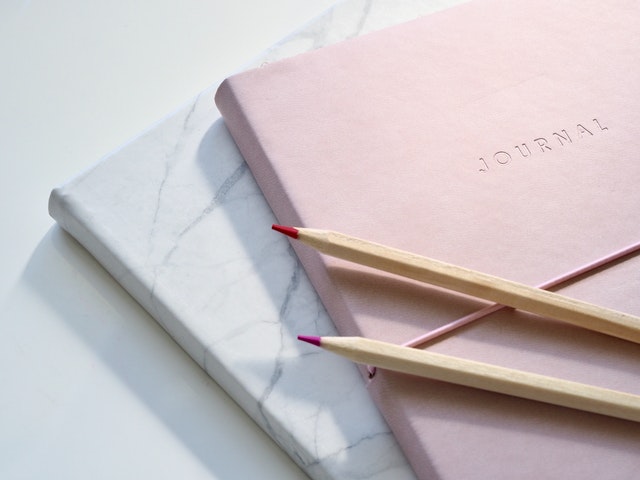I know it’s a bit out of character for us to promote something usually associated with Pinterest moms and lifestyle influencers but I assure you, no one is paying me to write this post. Well, the owners of Going Concern are but that’s beside the point.
I started bullet journaling last year and let me tell you it is a-mazing. This coming from someone who has been reprimanded for being an organizational disaster at every job I’ve ever had. I’m talking need a Post-it note on the fridge to remind me to eat disorganized. Now that I’m ancient, I’ve accepted that I’ll always have to deal with some level of this character flaw, though I’ve certainly tried to learn how to make it slightly less annoying to my colleagues over the years. But I haven’t totally given up hope on someday being able to find my keys in under 15 minutes.
When I got sober in 2020 (after locking down way too hard at the beginning of the pandemic ifyoufeelme), I realized I had all this free time that used to be spent blacked out and yelling at 12-year-olds in competitive Overwatch, so I took on some home improvement projects like painting my condo and organizing my junk drawer(s) and other such uncharacteristic life-sorting activities. The problem became my chipmunk-level attention span; it was hard to stick to one project at a time and see it through until it was finished. If I wanted to find a way out of the chaos I needed a solution. I tried various apps that purport to help you get organized only to quickly realize that these apps only work if you have some kind of foundational organization gene to begin with. That ain’t me.
Enter bullet journaling. I was attracted to the creative aspect of it but moreso how you can customize it to meet your needs. There are thousands upon thousands of bullet journal resources out there to straight up copy or draw inspiration from, and if you’re not the creative type you can even just print out templates.
Before we get to the fun part, perhaps a little backstory is in order. Bullet journaling — or the BuJo method — is the brainchild of fellow chaotic mind Ryder Carroll (here is a good New Yorker article on how and why he came up with it). His method has a few main components, though Pinterest warriors who swear by BuJo have adapted this method to include everything from trackers to inspirational quotes to entire pages upon which you can dump whatever’s on your mind in full graphic detail:
- Index
- Rapid logging
- Future log
- Bullets
This page from Carroll’s website explains the basics. I would suggest using his resources to learn what it’s all about before you start making colorful spreads (which is 100% what I did because rules are for suckers). Using rapid logging, you can organize tasks, notes, and events, and carry these items over to a new month if you couldn’t get to them in the current one. As the website tagline says, it’s mindfulness disguised as a productivity system.
This Oprah Daily article sums it up nicely and has a good checklist toward the bottom to help you get started:
Whether you need to get a better handle on your to-do list or want an outlet to help you relax, a bullet journal can help. But what exactly is a bullet journal? Think of it as a next-level diary for not only writing but also drawing. Instead of blank, lined pages, a bullet journal (or BuJo, for short) contains sections to log daily to-dos, keep a monthly or weekly calendar, jot down notes, track both physiological and mental health, and record both short- and long-term goals.
Start with an index page, that’s where you will keep track of your pages. At this stage, you might prefer to number your journal pages if your notebook isn’t pre-numbered like some bullet journal-specific notebooks are, though you can also do this as you go (or not at all like I do but I can’t suggest that). Then set up your future log over two to four pages with a dedicated space for each month — this is where you put the important bits in the months ahead, like exam dates you have scheduled. You’ll repeat this format somewhat for your monthly log, which is a snapshot for your month. Then do weekly and even daily logs to break things down further. This site has a good guide for setting up your BuJo in a matter of minutes and explains it far better than I can.
You with me? OK good.
Unsurprisingly my own bullet journal can get a bit chaotic. When I’m setting up my spreads for the month — spreads are related pages, so you might have a mental health spread with a mood tracker, a place to log if you took your meds that day, and a voodoo doll drawing of your least favorite partner that you draw pins on for example — I think about the main things I want to track, organize, and do for that month. So for January I have a work spread with a page for article ideas and a page to put notes from our weekly editorial meeting, a fitness spread to track workouts, a mood page because I’m bipolar af, a cleaning spread where I track what needs to be done around the house beyond throwing the dishes in the dishwasher, a bedtime checklist where I track the couple things I need to do before I crash out (empty the sink, scoop the cat shit, and bedtime skincare), and a free-form page to write down my wins for that month (like a rare nice comment from a reader, that’s a massive win since you people are usually so mean). Here, I’ll show you:

I’d like the record to reflect that I did in fact wash my face (“f” stamp) prior to January 3, I just didn’t get around to making that page until yesterday. Just so we’re clear.
Now, if you search “bullet journal” on Pinterest you will likely immediately close the window and run the other way thinking these people are insane because who has time to create these elaborate pages full of vibrant colors and perfect script. And you would be entirely justified in that reaction. Remember though that this is about making it your own, and if you want a simple journal then DO THAT. You don’t need a hoard of supplies to get started either, just a notebook and a pen. I use a cheap A5 dotted grid notebook, but literally any notebook will do. If you really want to be extra, do a search for recommended bullet journal notebooks. The Leuchtturm1917 is probably the most popular. Mildliner markers are great if you want to add some color and don’t bleed through pages. A ruler is good to have; I use a metal stencil that doubles as a bookmark. And if you want to get EXTRA extra like I did, you can use Sharpies, alcohol markers, POSCA markers (these are my favorite for outlines) gel pens, highlighters, colored pencils, stamps, stickers, and stencils to add flair to your journal. Hell, raid your kid’s backpack for crayons if you want. Anything goes, it’s yours to customize.
Once you’re all set up (sharing a second time in case you missed it, this is a good place to start), you can use your journal to track study sessions by week or by module, to remind yourself to keep up with your self care, to better organize other aspects of your life that you may be neglecting, and/or to track time. For example, you could adapt my cleaning tracker to track study time, just change “clean” to “study” and “20 minutes” to “1 hour” and boom, you’re tracking study time one hour at a time. For this page, one dot = 20 minutes, so if I’m feeling extra clean-y I set another timer and do another 20 minutes (big fan of The Pomodoro Technique over here).

I’ve found pages like this benefit me in several ways: first, it helps me remember TO do something and remember IF I did it, and second, it keeps me motivated because I like seeing checks in the boxes. It’s another way to gamify your life, basically. ADHD squad will know how important it is to motivate yourself to do unfun things any way you can, but all of us can relate to needing an extra push to get through the yuck stuff.
So those are the basics on bullet journaling and a few quick notes on how you can use it to organize your CPA exam study plan. Next week, I’ll share some study and time-tracking spreads to inspire you and help you meet your 2022 exam goals. In the meantime, what are you waiting for? Jump in!
Photo by Jess Bailey Designs from Pexels




“…like a rare nice comment from a reader, that’s a massive win since you people are usually so mean…”
This was funny — you know, in an acerbic wit kind of way — and made me laugh. Well done! (Well done with the whole post, in fact.)
Jason, is that you?
jk, thanks. This made my day!